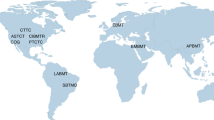Abstract
Hematopoietic stem cell transplantation (HSCT) is used widely for the treatment of malignant and non-malignant diseases. Advances in transplantation strategies such as modifications to existing transplant-conditioning regimens to lower morbidity and mortality, use of alternative donors and grafts, supportive care including graft-versus-host disease prophylaxis and antimicrobial therapy have led to increasing numbers of HSCT being performed. The procedure is now available to children, young and older adults with an ever increasing number of survivors from this procedure. Analysis of outcomes after HSCT giving consideration to existing strategies warrants using appropriate statistical methodology. This is critical not only in documenting the current success of HSCT but to plan future strategies to optimize accessibility to HSCT, donor and graft choices, patient selection, counsel potential HSCT candidates and long-term survivors and plan intervention trials for these persons. We describe concepts and principles of HSCT to better understand the complexities associated with outcome analysis.
Similar content being viewed by others
References
Bach FH, Albertini RJ, Joo P, Anderson JL, Bortin MM (1968) Bone marrow transplantation in a patient with the Wiskott Aldrich Syndrome. Lancet 2: 1364–366 doi:10.1016/S0140-6736(68)92672-X
Baron F, Sandmaier BM (2005) Current status of hematopoietic stem cell transplantation after nonmyeloablative conditioning. Curr Opin Hematol 12: 435–43 doi:10.1097/01.moh.0000177830.63033.9d
Caillat-Zucman S, Le Deist F, Haddad E, Gannage M, Dal Cortivo L, Jabado N, Hacein-Bey-Abina S, Blanche S, Casanova JL, A. Fischer A, Cavazzana-Calvo M (2004) Impact of HLA matching on outcome of hematopoietic stem cell transplantation in children with inherited diseases: a single-center comparative analysis of genoidentical, haploidentical or unrelated donors. Bone Marrow Transplant 33: 1089–095 doi:10.1038/sj.bmt.1704510
Curtis RE, Rowlings PA, Deeg HJ, Shriner DA, Socie G, Travis LB et al (1997) Solid cancers after bone marrow transplantation. N Engl J Med 336: 897–04 doi:10.1056/NEJM199703273361301
Curtis RE, Metayer C, Rizzo JD, Socie G, Sobocinski KA, Flowers MED et al (2005) Impact of chronic GVHD therapy on the development of squamous-cell cancers after hematopoietic stem-cell transplantation: an international case-control study. Blood 105: 3802–811 doi:10.1182/blood-2004-09-3411
Eapen M, Logan BR, Confer DL, Haagenson M, Wagner JE, Weisdorf DJ et al (2007) Peripheral blood grafts from unrelated donors are associated with increased acute and chronic graft-versus-host disease without improved survival. Biol Blood Marrow Transplant 13: 1461–468 doi:10.1016/j.bbmt.2007.08.006
Eapen M, Rubinstein P, Zhang M-J, Stevens C, Kurtzberg J, Scaradavou A et al (2007) Comparison of outcomes after transplantation of unrelated donor umbilical cord blood and bone marrow in children with acute leukemia. Lancet 369: 1947–954 doi:10.1016/S0140-6736(07)60915-5
Gatti RA, Meuwissen HJ, Allen HD, Hong R, Good RA (1968) Immunological recomstituiton of sex-linked immunological deficiency. Lancet 2: 1366–369 doi:10.1016/S0140-6736(68)92673-1
Gluckman E, Rocha V, Ionescu I, Bierings M, Harris RE, Wagner JE, Kurtzberg J, Chmapagne MA, Bonfim C, Bittencourt M, Darbyshire P, Fernandez MN, Locatelli F, Pasquini R for Eurocord-Netcord and EBMT (2007) Results of unrelated cord blood transplant in Fanconi anemia patients: risk factor analysis for engraftment and survival. Biol Blood Marrow Transplant 13:1073–082. doi:10.1016/j.bbmt.2007.05.015
Kernan NA, Bartsch G, Ash RC, Beatty PG, Champlin R, Filipovich A et al (1993) Analysis of 462 transplantations from unrelated donors facilitated by the National Marrow Donor Program. N Engl J Med 328: 593–02 doi:10.1056/NEJM199303043280901
Klein JP, Szydlo RM, Craddock C, Goldman JM (2000) Estimation of current leukemia-free survival following donor lymphocyte infusion therapy for patients with leukemia who relapse after allografting: application of a multistate model. Stat Med 19:3005–016. doi :10.1002/1097-0258(20001115)19:21<3005::AID-SIM592>3.0.CO;2-9
La Nassa G, Giardini C, Argiolu F, Locatelli F, Arras M, De Stefano P et al (2002) Unrelated donor bone marrow transplantation for thalassemia: the effect of extended haplotypes. Blood 99: 4350–356 doi:10.1182/blood.V99.12.4350
Laughlin MJ, Eapen M, Rubinstein P, Wagner JE, Zhang M-J, Champlin RE et al (2004) Outcomes after transplantation of cord blood or bone marrow from unrelated donors for adults with leukemia. N Engl J Med 351: 2265–275 doi:10.1056/NEJMoa041276
Lee SJ, Klein JP, Barrett J, Ringden O, Antin JH, Cahn JY et al (2002) Severity of chronic graft-versus-host disease: association with treatment-related mortality and relapse. Blood 100: 406–14 doi:10.1182/blood.V100.2.406
Rocha V, Labopin M, Sanz G, Arcese W, Schwerdtferger R, Bosi A et al (2004) Transplants of umbilical cord blood or bone marrow from unrelated donors in adults with acute leukemia. N Engl J Med 351: 2276–285 doi:10.1056/NEJMoa041469
Rubinstein P, Carrier C, Scaradavou A, Kurtzberg J, Admason J, Migliaccio AR et al (1998) Outcomes among 562 recipients of placental-blood transplants from unrelated donors. N Engl J Med 339: 1565–577 doi:10.1056/NEJM199811263392201
Schmitz N, Beksac M, Hasenclever D, Bacigalupo A, Ruutu T, Nagler A et al (2002) Transplantation of mobilized peripheral blood cells to HLA-identical siblings with standard risk leukemia. Blood 100: 761–67 doi:10.1182/blood-2001-12-0304
Schmitz N, Eapen M, Horowitz MM, Zhang M-J, Klein JP, Rizzo JD et al (2006) Long-term outcome of patients given transplants of mobilized blood or bone marrow: a report from the International Bone Marrow Transplant Registry and the European Group for Blood and Marrow Transplantation. Blood 108: 4288–290 doi:10.1182/blood-2006-05-024042
Socie G, Stone JV, Wingard JR, Weisdorf D, Henslee-Downey PJ, Cahn JY et al (1999) Long-term survival and late deaths after allogeneic bone marrow transplantation. N Engl J Med 341: 14–1 doi:10.1056/NEJM199907013410103
Wagner JE, Eapen M, MacMillan ML, Harris RE, Pasquini R, Boulad F et al (2007) Unrelated donor bone marrow transplantation for the treatment of Fanconi anemia. Blood 109: 2256–262 doi:10.1182/blood-2006-07-036657
Author information
Authors and Affiliations
Corresponding author
Rights and permissions
About this article
Cite this article
Eapen, M., Rocha, V. Principles and analysis of hematopoietic stem cell transplantation outcomes: the physician’s perspective. Lifetime Data Anal 14, 379–388 (2008). https://doi.org/10.1007/s10985-008-9090-4
Received:
Accepted:
Published:
Issue Date:
DOI: https://doi.org/10.1007/s10985-008-9090-4




